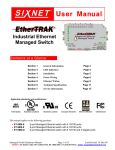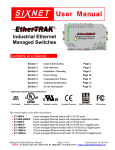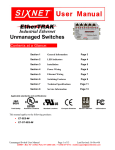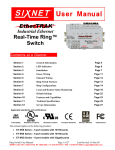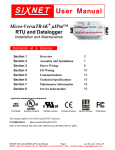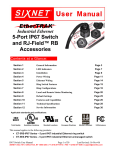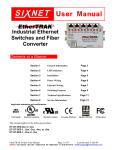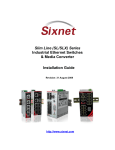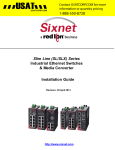Download Manual
Transcript
Slim Line (SL Series) Industrial Ethernet Switches & Media Converter Hardware Guide Contents at a Glance: Section 1 General Information Page 3 Section 2 LED Indicators Page 4 Section 3 Installation / Mounting Page 5 Section 4 Power Wiring Page 9 Section 5 Communication Wiring Page 10 Section 6 Technical Specifications Page 13 Section 7 Service Information Page 15 Applicable standards and certifications: RoHS Total Quality Electrical Safety European Directives US Emissions WEEE Compliant RoHS Compliant This manual applies to the following products: • • • • • SL-2ES-# SL-5ES-# SL-8ES/9ES-# SL-5MS-# SL-8MS-# 2-port unmanaged Ethernet media converter 5-port unmanaged Ethernet switch with 5 10/100 ports 8/9-port unmanaged Ethernet switch with 8 or 9 10/100 ports 5-port managed Ethernet switch with 5 10/100 ports 8-port managed Ethernet switch with 8 10/100 ports Slim Line Switch Hardware Manual Page 1 of 15 Last Revised: 3-Jan-07 SIXNET • 331 Ushers • Box 767 • Clifton Park, NY 12065 USA • +1 (518) 877-5173 • mailto: [email protected] SIXNET Protected Technology Policy - SIXNET protects your investment in SIXNET systems with long-term planned technology and our unique Protected Technology Policy. We will continue to support the specified capabilities of standard SIXNET products for at least five years (twenty years for Industrial Managed Switches). We plan each product improvement and new feature to be upward compatible with existing designs and installations. Our goals are to make each new software release bring new power to your SIXNET systems and have every existing feature, applications program and data file continue to work. We protect your investment even further with a liberal five-year trade-in policy. Exchange standard products for upgraded versions of the same product to take advantage of new features and improvements at any time for five years. A prorated trade-in allowance will be given for your existing unit. SIXNET protects your long-term productivity with state-of-the-art planned technology and continued support. SIXNET Statement of Limited Warranty - SIXNET, manufacturer of SIXNET products, warrants to Buyer that products, except software, manufactured by SIXNET will be free from defects in material and workmanship. SIXNET's obligation under this warranty will be limited to repairing or replacing, at SIXNET's option, the defective parts within one year of the date of installation, or within 18 months of the date of shipment from the point of manufacture, whichever is sooner. Products may be returned by Buyer only after permission has been obtained from SIXNET. Buyer will prepay all freight charges to return any products to the repair facility designated by SIXNET. This limited warranty does not cover losses or damages which occur in shipment to or from Buyer or due to improper installation, maintenance, misuse, neglect or any cause other than ordinary commercial or industrial applications. In particular, SIXNET makes no warranties whatsoever with respect to implied warranties of merchantability or fitness for any particular purpose. All such warranties are hereby expressly disclaimed. No oral or written information or advice given by SIXNET or SIXNET’s representative shall create a warranty or in any way increase the scope of this warranty. This limited warranty is in lieu of all other warranties whether oral or written, expressed or implied. SIXNET's liability shall not exceed the price of the individual units, which are the basis of the claim. In no event shall SIXNET be liable for any loss of profits, loss of use of facilities or equipment, or other indirect, incidental or consequential damages. INSTALLATION AND HAZARDOUS AREA WARNINGS - These products should not be used to replace proper safety interlocking. No software-based device (or any other solid-state device) should ever be designed to be responsible for the maintenance of consequential equipment or personnel safety. In particular, SIXNET disclaims any responsibility for damages, either direct or consequential, that result from the use of this equipment in any application. All power, input and output (I/O) wiring must be in accordance with Class I, Division 2 wiring methods and in accordance with the authority having jurisdiction. WARNING (EXPLOSION HAZARD) SUBSTITUTION OF COMPONENTS MAY IMPAIR SUITABILITY FOR CLASS 1, DIVISION 2 (ZONE 2). WARNING (EXPLOSION HAZARD) WHEN IN HAZARDOUS LOCATIONS, DISCONNECT POWER BEFORE REPLACING OR WIRING UNITS. WARNING (EXPLOSION HAZARD) DO NOT DISCONNECT EQUIPMENT UNLESS POWER HAS BEEN SWITCHED OFF OR THE AREA IS KNOWN TO BE NONHAZARDOUS. FCC Statement - This equipment has been tested and found to comply with the limits for a Class B digital device, pursuant to Part 15 of the FCC Rules. These limits are designed to provide reasonable protection against harmful interference in a residential installation. This equipment generates, uses and can radiate radio frequency energy and, if not installed and used in accordance with the instructions, may cause harmful interference to radio communications. However, there is no guarantee that interference will not occur in a particular installation. If this equipment does cause harmful interference to radio or television reception, which can be determined by turning the equipment off and on, the user is encouraged to try to correct the interference by one or more of the following measures: Reorient or relocate the receiving antenna; Increase the separation between the equipment and receiver; Connect the equipment into an outlet on a circuit different from that to which the receiver is connected; Consult the dealer or an experienced radio/TV technician for help. Copyright & Trademarks - Copyright ©2007 SIXNET, LLC. All Rights Reserved. Note: All information in this document is subject to change without notice. Slim Line Switch Hardware Manual Page 2 of 15 Last Revised: 3-Jan-07 SIXNET • 331 Ushers • Box 767 • Clifton Park, NY 12065 USA • +1 (518) 877-5173 • mailto: [email protected] Section 1 Overview General Information This manual will help you install and maintain these industrial Ethernet switches. Installation of these switches is very easy and they will begin to operate as soon as they are powered up. For the unmanaged models (denoted by ES in their part number) there are no user settings so they are truly plug and play. The managed models (denoted by MS in their part number) will act as unmanaged switches until they are configured otherwise. Refer to the managed switch software manual for configuration of advanced network functionality. Note: This manual only covers the installation and wiring of these switches. For the managed models refer to the separate Software User Manuals for details on configuring and using any of the management functions such as SNMP, RSTP, IGMP, VLANs, security, port mirroring and much more. Operation Unlike an Ethernet hub that broadcasts all messages out all ports, these industrial Ethernet switches will intelligently route Ethernet messages only out the appropriate port. The major benefits of this are increased bandwidth and speed, reduction or elimination of message collisions, and deterministic performance when tied with real-time systems. These industrial Ethernet switches can support 10BaseT (10 Mbps) and 100BaseT (100 Mbps) on their RJ45 ports. Each of these ports will independently auto-sense the speed and duplex, allowing you to interface to legacy (10 Mbps) or fast (100 Mbps) Ethernet devices. Some models also have one or two 100BaseF (100 Mbps) fiber optic ports. Performance Specifications These general specifications apply to these industrial Ethernet switches. Refer to Section 7 for complete technical specifications. Number of ports Ethernet Switch Type Ethernet Protocols RJ45 Ports (shielded) Fiber optic port speed Fiber optic wavelength Safety Standards 2, 5, 8 or 9 Ethernet ports Unmanaged (ES models) or managed (MS models) All standard IEEE 802.3 10/100 (with auto-negotiation, auto-crossover and autopolarity) 100 Mbps 1300 nm standard but special models are available These industrial Ethernet Switches meet the following standards plus others: Electrical safety - EN61010-1 (IEC1010) EMI emissions - FCC part 15, ICES 003, EN55022; Class B EMC immunity – IEC61326-1 Electrical safety – CUL (UL 508 & CSA C22); EN61010-1 (IEC1010) Install the Managed Switches in accordance with local and national electrical codes. Lightning Danger: Do not work on equipment during periods of lightning activity. Do not connect a telephone line into one of the Ethernet RJ45 connectors. Slim Line Switch Hardware Manual Page 3 of 15 Last Revised: 3-Jan-07 SIXNET • 331 Ushers • Box 767 • Clifton Park, NY 12065 USA • +1 (518) 877-5173 • mailto: [email protected] Section 2 Overview LED Indicators All these industrial Ethernet switches have 1 or 2 communication LEDs for each port and a power LED. The managed models also have an “OK” output LED, a status LED and dual power LEDs. Refer to the sample pictures below for the location of these LEDs. Power LED Status and Fiber LEDs The activity, link and speed LEDs are integrated into the RJ45 ports Power & OK LEDs Unmanaged Models (ES) Managed Models (MS) Typical LED Location (varies with model) Status LED Managed Models Only: The Status LED indicates the overall health of the switch. It is normally ON solid indicating that no internal CPU or software problems are detected. It will flash when loading firmware and briefly on power up or reset. Otherwise, if it is OFF or flashing for an extended period of time then a problem is detected. In this case, please contact SIXNET for support. Power LED On unmanaged models there is one power LED that is ON if either power input (P1 or P2) has power applied to it. On the managed models there are two Power LEDs (P1=primary and P2=backup) that indicate if there is power applied to the respective input. ACT / LNK LED This is the Yellow LED on models with two LEDs per RJ45 port. Indicates that there is a proper Ethernet connection (Link) between ON (yellow) the port and another Ethernet device, but no communications activity (not flashing) is detected. Indicates that there is a proper Ethernet connection (Link) between ON (yellow) the port and another Ethernet device, and that there is (flashing) communications activity. OFF Speed 10/100 LED Indicates that there is not a proper Ethernet connection (Link) between the port and another Ethernet device. Make sure the cable has been plugged securely into the ports at both ends. This is the Green LED on models with two LEDs per RJ45 port. ON (green) A 100 Mbps (100BaseT) connection is detected. OFF A 10 Mbps (10BaseT) connection is detected. Slim Line Switch Hardware Manual Page 4 of 15 Last Revised: 3-Jan-07 SIXNET • 331 Ushers • Box 767 • Clifton Park, NY 12065 USA • +1 (518) 877-5173 • mailto: [email protected] ACT / LNK / Speed LED OK LED This is a bi-color (green / yellow) LED on models with one LED per RJ45 port. Indicates that there is a proper Ethernet connection (Link) between ON Solid the port and another Ethernet device, but no communications activity (not flashing) is detected. Indicates that there is a proper Ethernet connection (Link) between the port and another Ethernet device, and that there is Flashing communications activity. Green A 100 Mbps (100BaseT) connection is detected. Yellow A 10 Mbps (10BaseT) connection is detected. OFF Indicates that there is not a proper Ethernet connection (Link) between the port and another Ethernet device. Make sure the cable has been plugged securely into the ports at both ends. Managed Models Only: This LED indicates the status of the power inputs. There is an output screw terminal that can be connected as shown in the wiring diagram. The output voltage from the screw terminal marked ‘OK’ will be the same as the applied switch input voltage. The output will be ON when both the PI and P2 terminals have power applied to them. It will be OFF if either input does not have power or the switch software is not running. Slim Line Switch Hardware Manual Page 5 of 15 Last Revised: 3-Jan-07 SIXNET • 331 Ushers • Box 767 • Clifton Park, NY 12065 USA • +1 (518) 877-5173 • mailto: [email protected] Section 3 Overview Installation These industrial Ethernet switches can be snapped onto a standard DIN rail (EN50022) or screwed directly to a flat panel. Refer to the mechanical drawings below to properly mount your switch. Note: Make sure to allow enough room to route your Ethernet copper or fiber optic cables. DIN Rail Mounting 1 1 Mounting 2 2 B B Removal A A Recommended DIN rail mounting steps: 1. Hook top back of unit over the din rail. 2. Push bottom back onto the din rail until it snaps into place. Recommended DIN rail removal steps: A. Insert screwdriver into din clip and pry until it released from the din rail. B. Unhook top of unit from din rail. Slim Line Switch Hardware Manual Page 6 of 15 Last Revised: 3-Jan-07 SIXNET • 331 Ushers • Box 767 • Clifton Park, NY 12065 USA • +1 (518) 877-5173 • mailto: [email protected] Snaps to standard DIN rail EN50022 (35 mm) 0.40" (1.02 cm) Typical for SC or ST fiber Removable Screw Block 1.98" [5.02 cm] 4.35" [11.05 cm] 3.95" [10.03 cm] Converter Dia. 0.15" (0.38 cm) Use for direct panel mounting to a flat surface 1.98" [5.02 cm] 3.26" [8.28 cm] 1.00" [2.54 cm] 0.06" [0.15 cm] Mechanical Dimensions for 2-Port Media Converter Snaps to standard DIN rail EN50022 (35 mm) 0.40" (1.02 cm) Typical for SC or ST fiber Removable Screw Block 1.98" [5.02 cm] 4.35" [11.05 cm] 3.95" [10.03 cm] Dia. 0.15" (0.38 cm) Use for direct panel mounting to a flat surface 3.26" [8.28 cm] 1.50" [3.81 cm] 1.00" [2.54 cm] 5 Port 1.98" [5.02 cm] 0.06" [0.15 cm] 8/9 Port Mechanical Dimensions for 5 or 8/9-Port Unmanaged Models Slim Line Switch Hardware Manual Page 7 of 15 Last Revised: 3-Jan-07 SIXNET • 331 Ushers • Box 767 • Clifton Park, NY 12065 USA • +1 (518) 877-5173 • mailto: [email protected] 0.51" [1.29 cm] Typical for SC or ST Fiber 4.22" [10.72 cm] 0.80" [2.04 cm] 1.92" [4.88 cm] Removable Screw Block SC Fiber 5.20" [13.21 cm] 5.05" [12.83 cm] ST Fiber Snaps to standard DIN Rail EN50022 (35 mm) Removable DIN clip for direct panel mounting Panel mounting ears accept up to a #8 screw 1.60" [4.07 cm] 1.07" [2.71 cm] 5 Port 1.90" [4.83 cm] Serial Port 0.53" [1.36 cm] 2.60" [6.60 cm] 2.60" [6.60 cm] 0.43" [1.10 cm] 3.82" [9.70 cm] 8 Port Mechanical Dimensions for 5 or 8-Port Managed Models The managed models allow you to choose the mounting method that best fits your requirements. Vertical snap-on DIN rail mounting for quickest installation and optimal rail width utilization Vertical screw-topanel mounting for better shock and vibration resistance Slim Line Switch Hardware Manual Flat screw-to-panel mounting for low profile orientation in shallow boxes plus best shock and vibration resistance. Page 8 of 15 Last Revised: 3-Jan-07 SIXNET • 331 Ushers • Box 767 • Clifton Park, NY 12065 USA • +1 (518) 877-5173 • mailto: [email protected] Section 4 Power and Output Wiring These industrial Ethernet switches can be powered from the same DC source that is used to power your other devices. A DC voltage in the range of 10 to 30 VDC needs to be applied between the P1 (plus) terminal and the Minus terminal as shown below. The chassis screw terminal should be tied to panel or chassis ground. To reduce down time resulting from power loss, these industrial Ethernet switches can optionally be powered redundantly with a second power supply as shown below. Overview The managed models also have an “OK” output that can be tied to a PLC input or other device to indicate when there is a power loss. When ON, this output will source the same voltage that is applied to the switches power terminals. See the wiring diagram below. Redundant DC Power Single DC Power OK P2 P1 Alarm Output Load OK P2 P1 Chassis GND (panel) + - Alarm Output Load One DC Supply + + - Chassis GND (panel) Dual DC Supplies Power & Alarm Wiring for Managed Switch Single DC Power Redundant DC Power P2 P1 P2 P1 + - Chassis GND (panel) + + - One DC Supply Chassis GND (panel) Dual DC Supplies Power Wiring for Unmanaged Switch and Media Converter Screw Torque When tightening the screws be careful to tighten to a max. torque of 3.48 lb-in. Slim Line Switch Hardware Manual Page 9 of 15 Last Revised: 3-Jan-07 SIXNET • 331 Ushers • Box 767 • Clifton Park, NY 12065 USA • +1 (518) 877-5173 • mailto: [email protected] Section 5 Communication Ports Wiring Overview These industrial Ethernet switches provide connections to standard Ethernet devices such as PLCs, Ethernet I/O, industrial computers and much more. Three types of communication ports may be found on these switches: RJ45 (copper) Ethernet ports, fiber optic Ethernet ports and a serial console port for management (managed models only). RJ45 Ethernet Wiring Use data-quality (not voice-quality) twisted pair cable rated category 5 (or better) with standard RJ45 connectors. For best performance use shielded cable. Straight through or crossover RJ45 cable can be used regardless of the device the switch is to be connected to as all the ports are capable of auto-mdi/mdix-crossover detection. The RJ45 Ethernet port connector bodies on these products are metallic and are connected to the Chassis GND terminal. Therefore, shielded cables may be used to provide further protection. To prevent ground loops, the cable shield should be tied to the metal connector body at one end of the cable only. Electrical isolation is also provided on the Ethernet ports for increased reliability. For Reference Only. Either cable wiring will work! Straight-thru Cable Wiring Pin 1 Pin 1 Pin 2 Pin 2 Pin 3 Pin 3 Pin 6 Pin 6 Cross-over Cable Wiring Pin 1 Pin 3 Pin 2 Pin 6 Pin 3 Pin 1 Pin 6 Pin 2 Ethernet Plug & Connector Pin Positions RJ45 Cable Distance The maximum cable length for 10/100/1000BaseT is typically 100 meters (328 ft.). Ethernet Fiber Wiring Guidelines These industrial Ethernet switches optionally have one or two pair of 100 Mbps (100BaseFX) multimode or singlemode fiber ports. The maximum segment length is up to 120 km or more depending on the type of fiber optic transceiver installed in the switch. Refer to the technical specifications for details. Each fiber optic port on the switch is comprised of a pair of SC or ST style connectors. For each fiber port there is a transmit (TX) and receive (RX) signal. When making your fiber optic connections, make sure that the transmit (TX) port of the switch connects to the receive (RX) port of the other device, and the receive (RX) port of the switch connects to the transmit (TX) port of the other device. Use standard fiber optic wiring techniques (not covered by this manual) to make your connections. The corresponding ACT/LNK LED will be ON solid when you have made a proper connection. See images below for typical fiber optic port placement. Slim Line Switch Hardware Manual Page 10 of 15 Last Revised: 3-Jan-07 SIXNET • 331 Ushers • Box 767 • Clifton Park, NY 12065 USA • +1 (518) 877-5173 • mailto: [email protected] Fiber Ports on Media Converter Typical SC Style Connector Typical ST Style Connector Fiber Ports on Unmanaged Models Fiber Ports on Managed Models Slim Line Switch Hardware Manual Page 11 of 15 Last Revised: 3-Jan-07 SIXNET • 331 Ushers • Box 767 • Clifton Park, NY 12065 USA • +1 (518) 877-5173 • mailto: [email protected] Duplex Operation The RJ45 ports will auto-sense for Full or Half duplex operation, while the fiber ports are configured for full duplex operation. Note: Fiber devices with half duplex settings should still communicate with the switch. If otherwise then please contact SIXNET. On managed models the duplex setting is software configurable. Network Device Check These industrial Ethernet switches are capable of supporting 10/100BaseT on the RJ45 (copper) ports and 100BaseF on the fiber optic ports. Make sure you connect the appropriate devices to each port. Verifying Connectivity After all Ethernet and/or fiber connections are made, check the LED’s corresponding to the ports that each of the devices are connected to. Ensure that for each port that is in use, the LED is on or blinking. If a port LED is off, go back and check for connectivity problems between that port and the network device connected to that particular port. In addition, the color of the LED should indicate the speed for which your device is connected at (see prior section on LEDs). Serial Console Port Wiring An optional way to configure the switch is through the RJ45 console RS232 port. Use a DB9F to RJ45F adapter along with a RJ45 male to RJ45 male straight-thru-wired patch cable to make a connection between a com port on your PC (DB9 male) and the RS232 port of the Managed Switch (RJ45 female). Contact SIXNET or your switch vendor to purchase this adapter as an accessory. A typical DB9F to RJ45F adapter should be wired as follows: Switch RJ45F Signal Pin # Name 1 RI/DSR in 2 DCD in 3 DTR out 4 GND 5 RXD in 6 TXD out 7 CTS in 8 RTS out Slim Line Switch Hardware Manual Adapter Signal DB9F Name Pin # DTR out 4 N/C n/c DSR in 6 GND 5 TXD out 3 RXD in 2 RTS out 7 CTS in 8 Page 12 of 15 Last Revised: 3-Jan-07 SIXNET • 331 Ushers • Box 767 • Clifton Park, NY 12065 USA • +1 (518) 877-5173 • mailto: [email protected] Section 6 Technical Specs Technical Specifications Here are the hardware technical specifications for the industrial Ethernet switches covered by this manual. For the managed models, refer to the software user manual or datasheet for complete software specifications. Copper RJ45 Ports: (10/100BaseT) 10/100BaseT ports Protocols supported Ethernet compliancy Auto-crossover Auto-sensing operation Auto-negotiating Auto-polarity Flow control Ethernet isolation Plug and play Cable requirements Max. cable distance Shielded RJ45 All standard IEEE 802.3 IEEE 802.3, 802.3u, 802.3x, 802.3z, 802.1p and more Yes, allows you to use straight or cross wired cables Yes, Full and half duplex Yes, 10BaseT and 100BaseT Yes, on the TD and RD pair Automatic 1500 VRMS 1 minute Yes Twisted pair (Cat. 5 or better) (shielded recommended) 100 meters SC or ST Fiber Ports: (100BaseF multimode or singlemode) 100BaseF ports Fiber port mode Fiber port connector Optimal fiber cable Center wavelength Multimode Singlemode Singlemode long haul Nominal max. distance (full duplex) (see web for details) Half and full duplex Ethernet compliance Eye safety Up to 2 Multimode (mm) or Singlemode (sm) Duplex SC or ST 50/125 or 62.5/125 µm for mm; 9/125 µm for sm 1300 nm (other wavelengths available) Links up to 4 km typ.; 1310 nm; use with 50 or 62.5/125 um fiber > Transmitter power (dB): -21 min, -17 typ, -14 max > Receiver sensitivity (dB): -34 typ, -31 max Links up to 20 km typical; 1310 nm; use with 9/125 um fiber > Transmitter power (dB): -15 min, -11 typ, -8 max > Receiver sensitivity (dB): -36 typ, -31 max Links up to 40 km typical; 1310 nm; use with 9/125 um fiber > Transmitter power (dB): -5 min, -3 typ, -0 max > Receiver sensitivity (dB): -36 typ, -34 max 4 km with multimode; 20 km with singlemode; up to 120 km with long haul singlemode Full duplex on unmanaged models; Software configurable on managed models 100BaseF IEC 60825-1, Class 1; FDA 21 CFR 1040.10 and 1040.11 Note: Additional fiber optic transceiver specifications are available. Also, other fiber transceivers may be available for special requirements such as longer distances, single strand or other special applications. Contact SIXNET for details. Slim Line Switch Hardware Manual Page 13 of 15 Last Revised: 3-Jan-07 SIXNET • 331 Ushers • Box 767 • Clifton Park, NY 12065 USA • +1 (518) 877-5173 • mailto: [email protected] General Specifications: Ethernet switch type Operating mode Devices supported Unmanaged or managed with up to 9 ports Store and forward wire speed switching, non-blocking All IEEE 802.3 compliant devices are supported SNMPv1/v2/v3, RMON, DHCP, SNTP, TFTP, STP, RSTP, QoS/CoS/ToS/DS, IGMPv1/v2, VLAN (tag and port based), HTTP, HTTPS (SSL & TSL), Telnet, SSH and more Modbus/TCP, EtherNet/IP, PROFInet, Foundation Fieldbus HSE and others Protocols (managed models only) Industrial protocols supported Standards (depends on model) Management interfaces (managed models only) Open source linux (managed models only) MAC addresses Memory bandwidth Latency for 10 Mbps ports Latency for 100 Mbps ports “OK” Output (managed models only) Voltage Maximum current output Management serial port (managed models only) Power input Input power (typical with all ports active at 100 Mbps) IEEE 802.3, 802.3u, 802.3x, 802.1D/w, 802.1p, 802.1Q Web (see online demo), text (Telnet & SSH), CLI (command line interface) and SNMP (see software manual for supported MIBs) The Linux Advantage - Contact SIXNET for more information 1024 on unmanaged models; 2048 on managed models 3.2 Gbps 16 us + frame time (typical) Varies on load and settings 5 us + frame time (typical) ON if P1 and P2 have power and switch software is running Same as switch input voltage 0.5 Amp RS232 (TXD, RXD and GND), 9600, 8, N, 1 fixed Redundant Input Terminals 2.0 W (2-port converter with 1 fiber), 2.0 W (5-port unmanaged w/o fiber), 3.0 W (5-port unmanaged w/ 1 fiber), 4.0 W (8-port unmanaged w/o fiber), 5.0 W (9-port unmanaged w/ 1 fiber), Input voltage (all models) Reverse power protection Transient protection Spike protection Ethernet isolation Operating temperature range Storage temperature range Humidity (non-condensing) Vibration, shock & freefall Electrical safety EMI emissions EMC immunity Eye safety (fiber models) MTBF RoHS and WEEE ISO9001:2000 Packaging and protection Dimensions (L x W x H) Weights (typical) Slim Line Switch Hardware Manual 3.6 W (5-port managed w/out fiber), 5.6 W (5-port managed w/ 2 fiber), 4.3 W (8-port managed w/out fiber), 16.3 W (8-port managed w/ 2 fiber) 10-30 VDC (continuous) Yes 15,000 watts peak 5,000 watts (10x for 10 uS) 1500 VRMS 1 minute -10 to +60 °C (cold startup at -10 °C); Contact SIXNET for wider operating temperature ranges -40 to +85 °C 5 to 95% RH IEC68-2-6, -27, -32 UL508/CSA C22, EN61010-1 FCC part 15, ICES-003, EN55022 IEC61326-1 IEC60825-1, Class 1; FDA 21 CFR 1040.10 and 1040.11 Mean Time Between Failure: >1,000,000 hours RoHS (Pb free) and WEEE compliant Certified "Total Quality" company Unmanaged models: IP30 with ABS plastic; Managed models: IP30 with Lexan & aluminum See mechanical diagrams for details 4 oz (0.11 kg) for converter and 5-port unmanaged; 6 oz (0.17 kg) for 8/9-port unmanaged; 8 oz (0.23 kg) for 5-port managed; 10 oz (0.28 kg) for 8-port managed Page 14 of 15 Last Revised: 3-Jan-07 SIXNET • 331 Ushers • Box 767 • Clifton Park, NY 12065 USA • +1 (518) 877-5173 • mailto: [email protected] Section 7 Service Information Service Information We sincerely hope that you never experience a problem with any SIXNET product. If you do need service, call SIXNET at (518) 877-5173 and ask for Applications Engineering. A trained specialist will help you to quickly determine the source of the problem. Many problems are easily resolved with a single phone call. If it is necessary to return a unit to us, an RMA (Return Material Authorization) number will be given to you. SIXNET tracks the flow of returned material with our RMA system to ensure speedy service. You must include this RMA number on the outside of the box so that your return can be processed immediately. The applications engineer you are speaking with will fill out an RMA request for you. If the unit has a serial number, we will not need detailed financial information. Otherwise, be sure to have your original purchase order number and date purchased available. We suggest that you give us a repair purchase order number in case the repair is not covered under our warranty. You will not be billed if the repair is covered under warranty. Please supply us with as many details about the problem as you can. The information you supply will be written on the RMA form and supplied to the repair department before your unit arrives. This helps us to provide you with the best service, in the fastest manner. Normally, repairs are completed in two days. Sometimes difficult problems take a little longer to solve. If you need a quicker turnaround, ship the unit to us by air freight. We give priority service to equipment that arrives by overnight delivery. Many repairs received by mid-morning (typical overnight delivery) can be finished the same day and returned immediately. We apologize for any inconvenience that the need for repair may cause you. We hope that our rapid service meets your needs. If you have any suggestions to help us improve our service, please give us a call. We appreciate your ideas and will respond to them. For Your Convenience: Please fill in the following and keep this manual with your SIXNET system for future reference: P.O. #:__________________ Date Purchased: ___________________ Purchased From:______________________________________________ Product Support To obtain support for SIXNET products: On-line support: http://www.get2support.com Order on-line: http://www.sixnetstore.com Latest product info: http://www.sixnetswitch.com Phone: +1 (518) 877-5173 Fax: +1 (518) 877-8346 E-mail: mailto: [email protected] Mailing address: SIXNET, 331 Ushers Road, P.O. Box 767, Clifton Park, NY 12065 Slim Line Switch Hardware Manual Page 15 of 15 Last Revised: 3-Jan-07 SIXNET • 331 Ushers • Box 767 • Clifton Park, NY 12065 USA • +1 (518) 877-5173 • mailto: [email protected]















